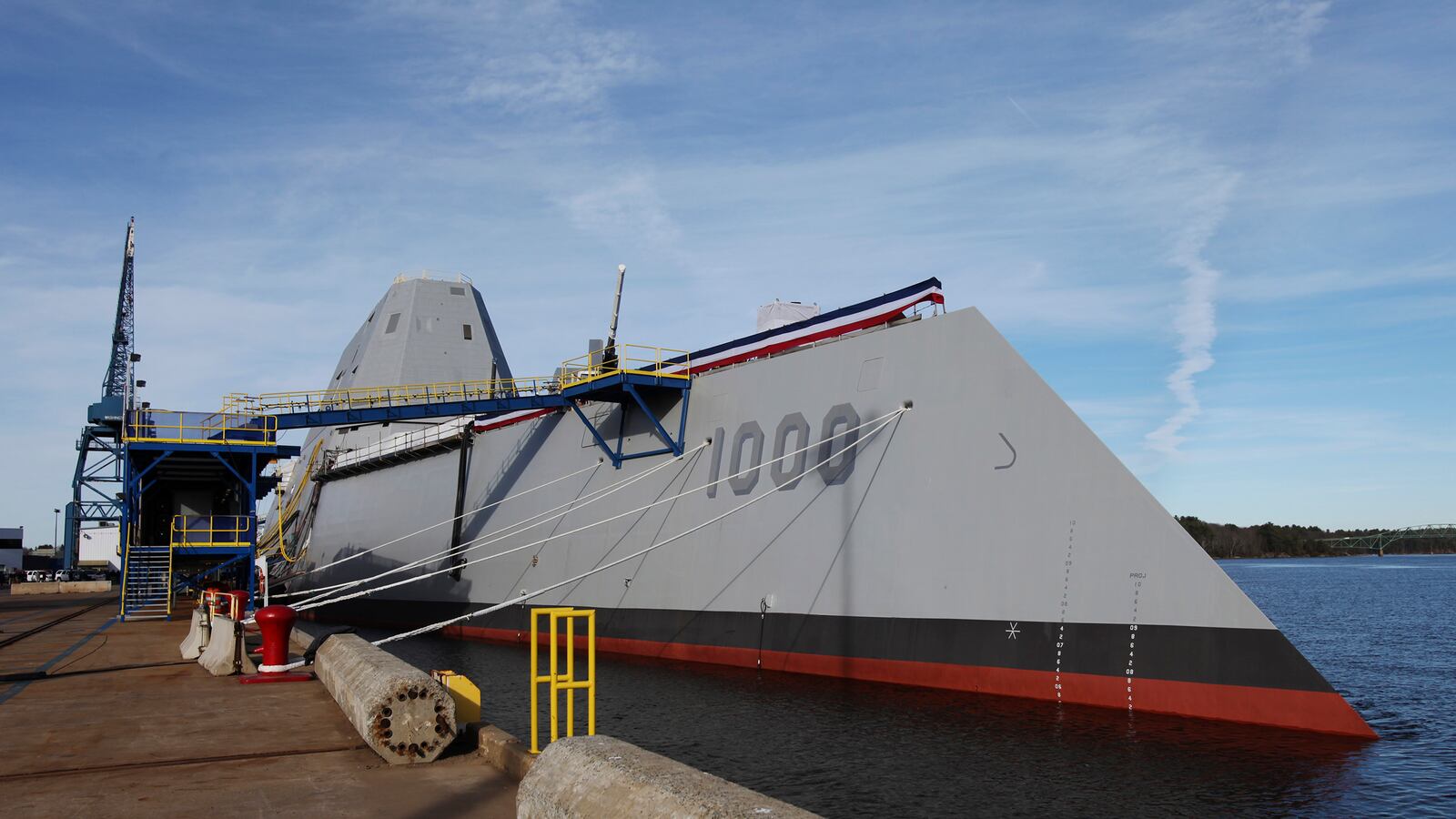September was supposed to be a triumphant month for the Zumwalt, the U.S. Navy’s high-tech new destroyer. The 600-foot-long, missile-armed stealth warship—its hull and superstructure sharply sloped to help it avoid radar-detection—was in Norfolk, Virginia, undergoing last-minute tests before its planned official commissioning on Oct. 15.
Once in service, the Zumwalt will be the Navy’s most sophisticated destroyer. But only if it actually works.
On Sept. 19, the Zumwalt suffered what the Navy calls an “engineering casualty.” In plain language, that means the $4 billion ship broke down. And it wasn’t alone. Across the world’s leading navy, new warships are breaking down at alarming rates.
Americans should worry. The Navy is busier than ever fighting ISIS, deterring Russian aggression in the Black Sea, and patrolling the western Pacific to blunt Chinese land-grabs. A fleet can’t fight, deter, and patrol if its ships can’t sail.
Zumwalt’s problem began with a trickle of saltwater. “The crew discovered the casualty after detecting a seawater leak in the propulsion motor drive lube oil auxiliary system for one of the ship’s shafts,” a Navy spokesperson told the news website of the U.S. Naval Institute.
The Navy insisted the Zumwalt could still safely sail, owing to the “built-in redundancy of the ship’s propulsion plant.” The new destroyer is, in essence, a seagoing version of a hybrid car, with gas-fueled turbine engines for routine operations and batteries for back-up power. Shut down one propulsion system, and you can still get underway on the other.
But with commissioning just weeks away, the sailing branch isn’t taking any chances. “It was determined that the repairs should be completed in port prior to the ship transiting to sea,” the spokesperson told USNI News.
Zumwalt’s breakdown was just the latest in a long chain of mechanical problems afflicting the Navy’s newest ships—in particular, the roughly 400-foot-long Littoral Combat Ships that are on track to become one the fleet’s most numerous vessel types.
New Littoral Combat Ships, each of which cost around $500 million to build, have broken down no fewer than fives times in 2016 and late 2015. Most recently, on Sept. 13, the USS Montgomery suffered two unrelated engineering casualties while sailing from Mayport, Florida, to its new home port of San Diego via the Panama Canal. The Montgomery had officially been in service for less than a week when the breakdowns occurred.
The first problem was a leak like the one that would sideline Zumwalt just a few days later. Later the same day, one of the Montgomery’s two gas turbines broke down. The Navy issued a statement that would match, almost word-for-word, its later explanation for Zumwalt’s engineering casualty.
“The built-in redundancy of the ship’s propulsion plant allows these ships to operate with multiple engine configurations,” the Navy explained. “However… it was determined that the best course of action would be to send the ship to Mayport to conduct both repairs.”
Montgomery’s sister ships have spent a lot of time in port lately. In late August, the Hawaii-based Coronado developed engine problems that forced the Navy to cancel a planned deployment to the western Pacific. Freedom limped home to San Diego in early July after springing a leak that wrecked its backup diesel engine.
In January, the Fort Worth’s crew accidentally stripped her gears in Singapore. The Navy fired the ship’s captain. A few months earlier, the Milwaukee suffered similar damage to its own gears—only this time, a software glitch was to blame.
To be fair, all ships—especially new ones—experience mechanical problems. In most cases, the crew or workers ashore quickly repair the damage and, over time, resolve any underlying issues, thus making future breakdowns less frequent and less severe. But there are reasons to be especially worried about the recent spate of engineering casualties.
Both the Littoral Combat Ships and the Zumwalt-class vessels are, more than most warships, designed around their engines—albeit for different reasons. The Navy wanted the LCS to be fast—and to use that extra speed to respond more quickly to threats. Where most warships top out at speeds just over 30 knots—around 35 miles per hour—the LCSs can easily make 40 knots.
Achieving that speed meant wrapping a lightweight vessel around a powerful propulsion system. When this reporter toured the Freedom in 2009, operations officer Tony Hyde proudly showed off diesel engines, gas turbines, gears, shafts, and other components that together ran nearly the whole length of the ship. “These are the largest marine gas turbines in the world—essentially the engines of a 777 jetliner,” Hyde said. “The diesels we have [are] locomotive engines.”
The LCS’s gas turbines produce 100,000 horsepower. But all that power and speed comes at a cost. “Overall costs of the LCS are largely driven by the speed requirement,” Adm. James Lyon, former commander of the U.S. Pacific Fleet, wrote in The Washington Times. “It can be safely assumed that between 30 percent and 40 percent of the current hull, mechanical, and electrical… costs are directly attributed to the speed requirement.”
Eager to keep down the LCS’s price tag, the Navy stripped the design of armor and heavy weaponry and cut the crew to the smallest possible size—initially just 75 sailors, fewer than half as many as crewed the older guided-missile frigates the LCSs replaced.
It didn’t take long for the Navy to decide that 75 people couldn’t keep an LCS in working order. “Data from LCS operations, particularly from Freedom’s early operational deployment and performance during major fleet exercises, suggested the need to increase the core crew complement to accommodate more maintenance and watch requirements,” the Navy reported following a 2013 study.
Two years later, the study’s assertion apparently proved true as LCSs started breaking down at sea. In the midst of the crisis in August, Vice Adm. Tom Rowden—commander of all Navy surface ships—ordered LCS crews to temporarily stand down while the Navy reviewed its procedures.
A few weeks later, Adm. John Richardson—the Navy’s top officer—announced that LCS crews would grow to 93 sailors.
It’s not clear yet whether a bigger crew will mean fewer breakdowns. But the Navy is counting on it. The sailing branch has eight LCSs and plans to buy an additional 32 of the speedy warships. By the mid-2020s, LCSs could make up nearly 15 percent of the U.S. fleet.
To help the Navy keep up with a rising China, an increasingly aggressive Russia, and the U.S.-led campaigns targeting Islamist militants, the Navy wants LCSs to spend as much as half their time in combat, compared to other ship types that are forward-deployed just 20 percent of the time. To spend that much time at sea, the LCSs will need to be more reliable than other ships. At present, they’re proving to be less reliable.
By contrast, the Navy is only buying three Zumwalt-class ships. The stealthy destroyers won’t ever comprise a significant proportion of the fleet.
But they’re not supposed to. The Navy considers the Zumwalts to be science experiments as much as they are operational warships. The type’s most important feature is its built-in, 78-megawatt electrical grid supporting an advanced, ship-wide computer network that Zumwalt’s first skipper, Capt. James Kirk—yes, you read that right—has compared to a human brain.
The catch is that the on-board electrical grid draws power directly from the ship’s engines. When the engines don’t work, the grid fails. As with the LCS, Zumwalt routinely sails with just half as many sailors as the older ships it’s replacing—140 people in Zumwalt’s case.
The Navy told USNI News that Zumwalt’s engineering casualty won’t delay its October commissioning. If the sailing branch is worried that Zumwalt, too, might ultimately need a bigger crew in order to prevent its mechanical problems from recurring, it hasn’t admitted it yet.
One thing’s for certain. To deploy a bigger and better fleet, the Navy first needs to be confident that its new ships can actually sail without breaking down.





